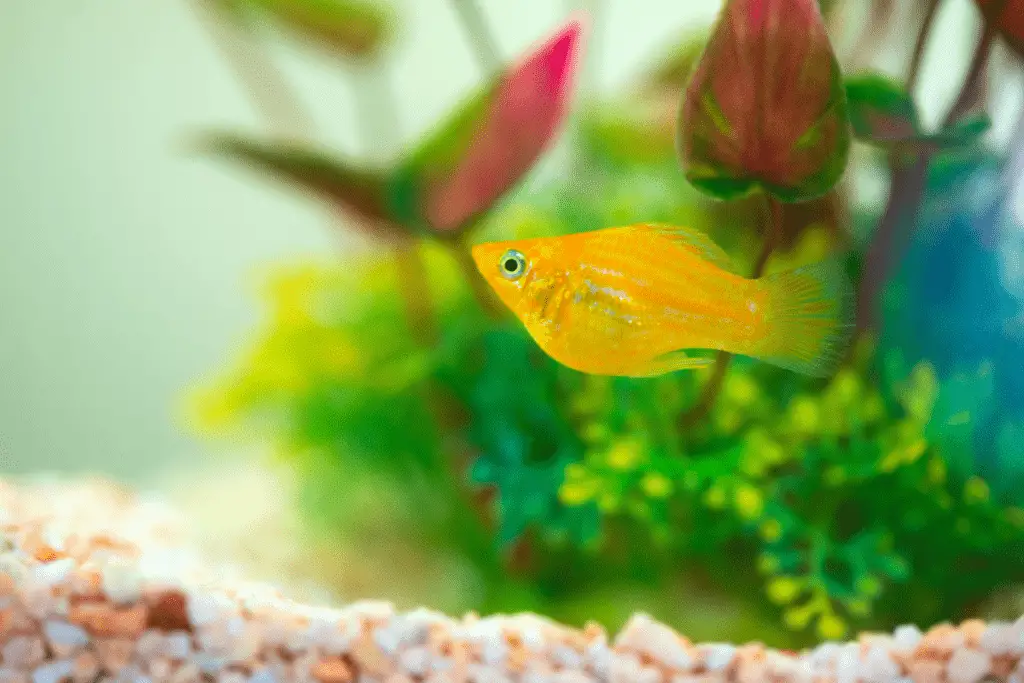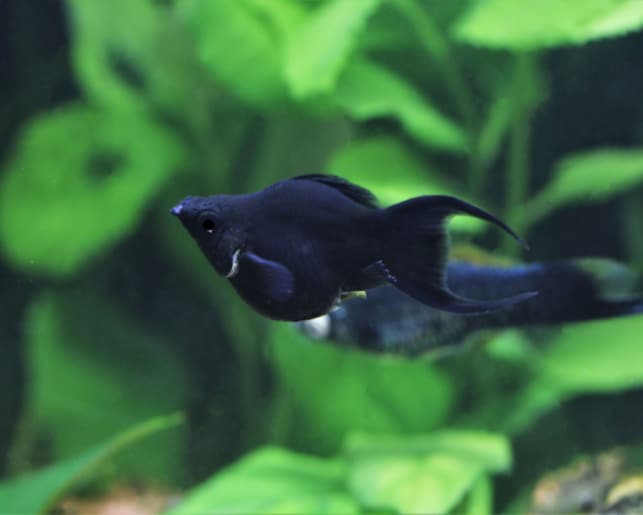Molly fish are known for their impressive ability to reproduce. They aren’t quite at guppy level, but they aren’t far off!
Mollies are one of the few fish species that carry the eggs internally and give birth to fry. So, how can you tell if you have a pregnant molly?
A pregnant molly’s gravid spot will become bigger and darker as the pregnancy progresses. Her abdomen will also increase in size and develop a boxy shape towards the end of her pregnancy. In addition, her eating habits may change, and she will become aggressive towards other fish before birth.
Mollies are pregnant for anywhere between 40 to 70 days, giving you little time to prepare for your new arrivals. To help you prepare for your first batch of baby mollies, we will discuss how to tell if your molly fish is pregnant, what to do when a molly is pregnant, and what to do before and after she gives birth to the fry.
How Can You Tell If A Molly Fish Is Pregnant?
If you are a new molly owner, you might be excited and nervous about your first molly pregnancy. If your mollies are in a suitable environment free from stressors, such as predator fish, you will probably have fry within two months of them joining your tank (as long as you have at least one male and one female, obviously…).
Mollies are ovoviviparous, meaning that the female molly keeps the eggs in her body as they develop. She then gives birth to the fry when they have already hatched. An easier term for this is that they ae live-bearing fish.
All this is to say that you will most likely have fry at one stage or another. In fact, you’ll likely have fry quite often, which you can then sell or gift when they are mature. As this is the case, you must know how to determine if a molly is pregnant and what to do when you discover she is.
There are a few signs to look out for to confirm if your molly is pregnant. The first sign is the growing gravid spot on her abdomen. Female mollies have a small black spot on their abdomens where the fry will develop if they’re pregnant. During pregnancy, the gravid spot will grow bigger and become darker. The spot will continue growing until the guppy gives birth, when it will be at its biggest.
Another sign that your molly is pregnant is a growing abdomen. The molly’s abdomen will get bigger and bigger as the fry develop. Before she gives birth, her abdomen will have a more boxed shape and look like she is bloated or fat.

The next indicator that a molly is pregnant is her eating habits. She will likely eat more food at first. Then, as her abdomen grows, there isn’t enough space for a lot of food, and she will start eating less.
Finally, your molly might become hostile towards other fish, especially male mollies, if she is pregnant. She’ll attack them if they try to mate with her. This, too, increases as her pregnancy progresses, and she will be the most aggressive before giving birth.
These are the signs that your molly could be pregnant, which is bound to happen if she is in a safe and thriving environment and there are male mollies in the tank.
What Should You Do If Your Molly Fish Is Pregnant?
You may feel very excited when you first realize your molly is pregnant. Watching a molly’s pregnancy and birth is a fascinating experience for any guppy owner. So what can you do to prepare for the birth of your molly’s fry?
There isn’t much to do when your fish is pregnant. If your fish tank doesn’t have an isolation tank, we recommend buying one before they give birth. The isolation tank will help your molly relax while she gives birth and prevents the fry from being eaten by the other fish.
Some isolation tanks have a separate compartment for the fry, like this one. These tanks are ideal for mollies, as the fry has a safe space to mature where the mother and other fish can’t eat them. Mollies will try to eat their fry, so separating them is crucial if you want them to live.
Another thing you can do when your molly is pregnant is to feed her a variety of food. Include fish food flakes, fresh brine shrimp, frozen blood worms, and spirulina flakes. These foods will help the fry develop and ensure the mother is well-nourished during the pregnancy.
As her pregnancy progresses, your molly won’t be able to eat as much food at once anymore. Therefore, we recommend feeding her smaller meals throughout the day to keep her well fed and ensure there isn’t too much food waste in the tank.
Your molly will be ready to give birth to her fry within two months! So what should you do when your molly is going into labor?

What To Do When A Molly Fish Gives Birth.
You will be able to tell that your molly fish is close to giving birth by the shape of her abdomen. You know that labor is close when it develops a more boxed shape. The gravid spot will also be huge and dark when she is close to giving birth.
Gently move the molly from the main tank to the breeder tank, where she can peacefully give birth to her fry. You have to get the timing of this right. If you leave it too late, there is a chance she will panic and abort her fry early. If she hasn’t delivered any fry within 48 hours after moving her, place her back in the main tank and slightly raise the temperature.
However, if you move her to the breeder tank when she is about to deliver, you can watch as the baby fry are born. Some eggs may be undeveloped, and some fry may not survive. However, there should be between 20 and 60 new fry in the isolation tank if all goes well. A molly can take between 1 and 6 hours to deliver all the fry. In some cases, it can also take up to twelve hours.
Additionally, your molly may start breathing fast. She may swim up to the tank’s surface and look like she is panting when she is close to labor. She will also start nesting, which means that she will find one corner in the tank and stay there, attacking any other tankmates that come close.
A molly fish will have contractions. You can see these contractions by the way she moves. Her back will be straight, and her tail will point upwards when she has a contraction. When you notice these signs, you should prepare for the fry.
This short video shows you signs to indicate your molly fish is about to give birth.
How To Care For A Molly and Her Fry After Birth.
If you have a separate section in the breeder tank for the fry, leave them there for a few days to mature. Also, leave the mother in her isolation tank for 24 – 48 hours after delivery so she has time to rest and recover. Then, feed the mother nutrient-dense food so she can regain her strength. After that, place her back in the main tank.
Feed the fry often so they can grow big and strong. Experts recommend feeding them up to 5 times per day. The fry must be big enough, so the adults won’t eat them before moving them to the main tank. This can take a few weeks. Determine the sex of the fry before moving them and sell or gift the fry you don’t have space for.
Conclusion.
Mollies have a gestational period of anywhere between 40 to 70 days, giving you little time to prepare for their arrival. A pregnant molly’s gravid spot grows bigger and darkens. Her abdomen swells and develops a more boxed shape. Her eating patterns change, and she can also become more irritable. If you notice these signs, there’s a good chance you will be welcoming fry into your tank within a month or two.
Further Articles about Mollies:
Do mollies really eat their babies?
How to stop a bullying molly fish.

